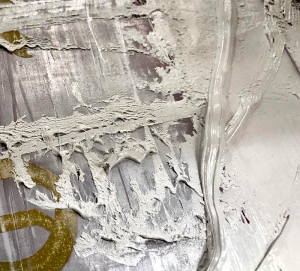Why is My Low-Cure Ink Gelling in the Screen?
August 23, 2019
 In an article recently published by Impressions Magazine, our Kieth Stevens gives us another valuable tip regarding low-cure inks.
Low-Cure inks are formulated to cure at around 275°F (135°C), and as such, tend to have a very fast flashing time. This means that when the ink is exposed to heat under the flash, it gels very quickly.
Inks with fast—or short—flashing times allow for faster production speeds, as the print needs to spend less time under the flash unit. This also means that these types of inks are more sensitive to heat overall.
During the print process, especially when using an automatic press, the platens and screens get heated up from all of the residual ambient heat of the flash unit where, depending on the amount of colors or special effects being used, the print can be flashed more than once. Regardless of whether a low-cure or standard-cure ink is being used, the extra heat can affect the performance of the ink. Since low-cure or fast-flashing inks are formulated to cure at lower temperatures, they are more sensitive to heat and thus tend to react faster to heat exposure. In the course of the platen and screen being heated up, the ink in the screen is also heating up. The result is that the ink starts gelling in the screen and becomes unusable.
Because of the extra heat the platens and screens retain, it’s good practice not to over-load the screens with ink. Fill the screen with smaller amounts of ink more frequently rather than loading a large amount of ink into the screen to last for the day. It’s also good practice to periodically scoop the ink that accumulates at the sides, front, and rear of the squeegee and place it back towards the middle of the screen, into the squeegee’s path. If the printing is to continue the following day, only load enough ink to finish for the day rather than leaving a large amount overnight on the hot screens.
If partially gelled ink does form in the heated screen, it’s best to remove and simply dispose of it as it is no longer usable. The viscosity and print-ability have been altered and fresh ink would assure that the print quality is not compromised. Again, the gelling can be partly avoided by adding less ink more often during the production run and then trying to finish the day with as little ink in the screen as possible so that the next day’s production run can be continued with again, fresh ink. “Consume the ink faster than it can gel” is the point.
I have had to either clean a gelled ink out of a screen or even had to re-burn a screen more than once due to not heeding this principle of using less ink and replacing it more often.
In an article recently published by Impressions Magazine, our Kieth Stevens gives us another valuable tip regarding low-cure inks.
Low-Cure inks are formulated to cure at around 275°F (135°C), and as such, tend to have a very fast flashing time. This means that when the ink is exposed to heat under the flash, it gels very quickly.
Inks with fast—or short—flashing times allow for faster production speeds, as the print needs to spend less time under the flash unit. This also means that these types of inks are more sensitive to heat overall.
During the print process, especially when using an automatic press, the platens and screens get heated up from all of the residual ambient heat of the flash unit where, depending on the amount of colors or special effects being used, the print can be flashed more than once. Regardless of whether a low-cure or standard-cure ink is being used, the extra heat can affect the performance of the ink. Since low-cure or fast-flashing inks are formulated to cure at lower temperatures, they are more sensitive to heat and thus tend to react faster to heat exposure. In the course of the platen and screen being heated up, the ink in the screen is also heating up. The result is that the ink starts gelling in the screen and becomes unusable.
Because of the extra heat the platens and screens retain, it’s good practice not to over-load the screens with ink. Fill the screen with smaller amounts of ink more frequently rather than loading a large amount of ink into the screen to last for the day. It’s also good practice to periodically scoop the ink that accumulates at the sides, front, and rear of the squeegee and place it back towards the middle of the screen, into the squeegee’s path. If the printing is to continue the following day, only load enough ink to finish for the day rather than leaving a large amount overnight on the hot screens.
If partially gelled ink does form in the heated screen, it’s best to remove and simply dispose of it as it is no longer usable. The viscosity and print-ability have been altered and fresh ink would assure that the print quality is not compromised. Again, the gelling can be partly avoided by adding less ink more often during the production run and then trying to finish the day with as little ink in the screen as possible so that the next day’s production run can be continued with again, fresh ink. “Consume the ink faster than it can gel” is the point.
I have had to either clean a gelled ink out of a screen or even had to re-burn a screen more than once due to not heeding this principle of using less ink and replacing it more often.


